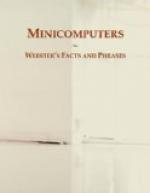|
This section contains 1,087 words (approx. 4 pages at 300 words per page) |

|
Minicomputers (sometimes called the "mini") are defined primarily in terms of price and size. Minicomputers generally have a word size of 8–18 bits (register size); a memory size of 32,000–64,000 16-bit words, or 16,000–32,000 32-bit words; a processing speed of 200–300 kilo-instructions per second (KIPS); and a price in the range of $3,000 to $50,000. The large processors of the 1970s and 1980s cost from $50,000–$100,000 to several million dollars. The mini was an economical solution to low-end, smaller computing.
 A computer user operates metallurgical testing equipment, which is controlled by a minicomputer.
A computer user operates metallurgical testing equipment, which is controlled by a minicomputer.
The mini was relatively small, less than 0.6-meters (two-feet) wide, and mounted in a rack. Its advent also spurred the development of peripherals that had to be developed at a price consistent with that of the mini while providing satisfactory performance.
Some applications of the minicomputer were data acquisition, process control, time-sharing, and terminal and peripheral communication control. Process control systems involve...
|
This section contains 1,087 words (approx. 4 pages at 300 words per page) |

|


